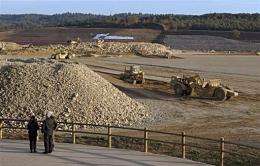Nuclear fusion power project to start in 2018: official

An experimental reactor that could harness nuclear fusion, the power that fuels the Sun, will begin operation in southern France in 2018, the project's governing body announced Thursday.
The International Thermonuclear Experimental Reactor (ITER) should be fully operational in 2026, the ITER Council said in a communique after a meeting in Japan.
The seven-nation council endorsed a "phased" completion of the multi-billion-dollar reactor, with a target date for "first plasma" by the end of 2018.
ITER is designed to produce 500 megawatts of power for extended periods, 10 times the energy needed to keep the energy-generating plasma -- a form of radioactive gas -- at extremely high temperatures.
It will also test a number of key technologies for fusion including the heating, control and remote maintenance that will be needed for a full-scale fusion power station.
Preliminary trials would use only hydrogen. Key experiments using tritium and deuterium that can validate fusion as a producer of large amounts of power would not take place until 2026.
Launched in 2006 after years of debate, the pilot project at Cadarache, near Marseille, has seven backers: the European Union (EU), China, India, South Korea, Japan, Russia and the United States. Kazakhstan is poised to become the eighth member.
Nuclear fusion entails forcing together the nuclei of light atomic elements in a super-heated plasma, held in a doughnut-shaped chamber called a tokamak, so that they make heavier elements and in so doing release energy.
The process, used by the Sun and other stars, would be safe and have negligible problems of waste, say its defenders.
In contrast, nuclear fission, which entails splitting the nucleus of an atom to release energy, remains dogged by concerns about safety and dangerously radioactive long-term waste.
Four years ago, ITER was priced at around 10 billion euros (13.8 billion dollars today), spread among its stakeholders, led by the EU, which has a 45-percent share.
Five billion euros (6.9 billion dollars) would go to constructing the tokamak and other facilities, and five billion euros to the 20-year operations phase.
Last month, the British science journal Nature said construction costs "are likely to double" and the cost of operations "may also rise."
"We are in the process of calculating the final cost of the project," ITER spokesman Neil Calder told AFP. "The financing plan will be presented in November at the next meeting of the council."
If ITER is a success, the next step would be to build a commercial reactor, a goal likely to be further decades away.
(c) 2009 AFP

















